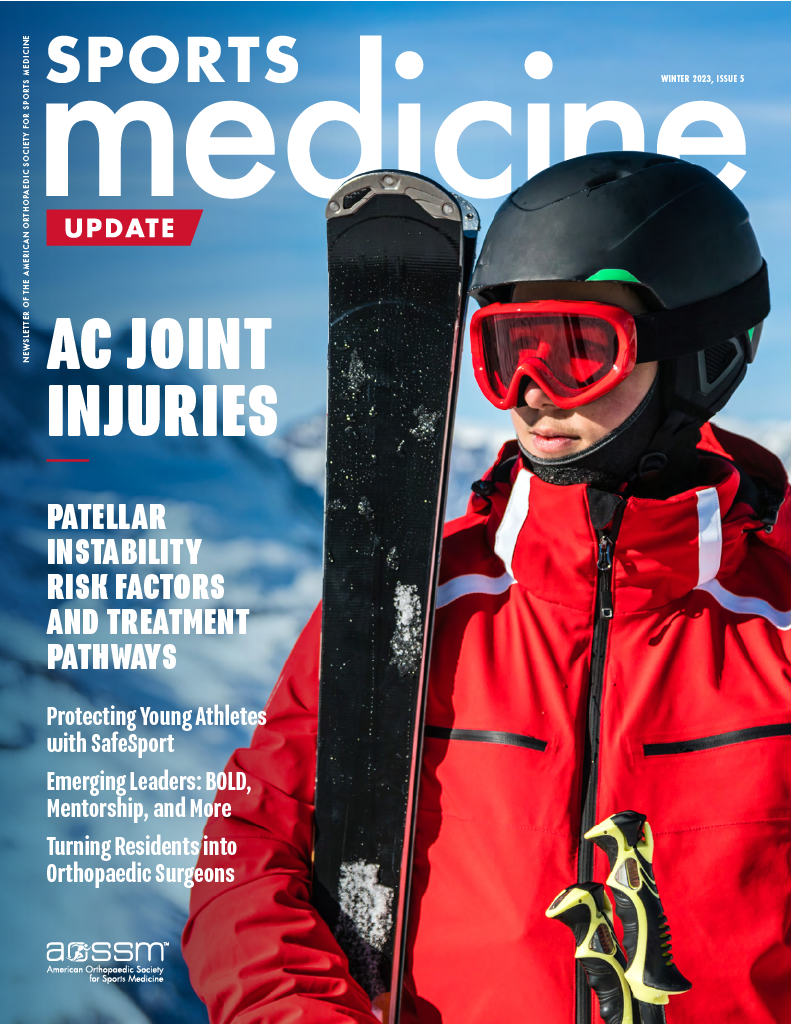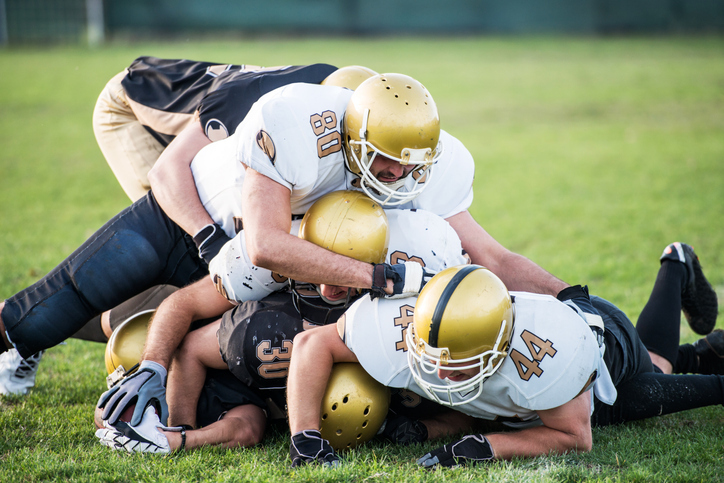As the snow starts to fly this winter, avid winter athletes think about skiing, snowboarding, ice hockey—and AC joint injuries.

AC joint injuries typically occur from a fall or a blow on the adducted arm. These injuries occur more commonly in young men during the first three decades of life,1 and frequently are associated with fall and winter sports, including football, skiing, snowboarding and ice hockey. AC joint injuries represent almost a third of all shoulder injuries in the National Football League (NFL)2 and are the most common upper extremity injury in ice hockey players.3 AC joint injuries represented 6.7% of annual emergency visits at a Colorado ski resort, with more than half of those (62.2%) occurring in snowboarders.4
The AC Joint
The AC joint is a small diarthrodial joint with a fibrocartilaginous disk and has both vertical and horizontal stabilizers. Reconstructive surgery has focused on the coracoclavicular (CC) ligaments, or conoid and trapezoid ligaments, which are the vertical stabilizers. However, more emphasis recently has focused on understanding the horizontal stabilizers of the AC joint. While the CC ligaments do confer some horizontal stability, the AC joint capsule contributes directly to stability, including a superior-posterior thickening and a more variable anterior-inferior thickening of the capsule.5 The AC capsule and ligaments (the AC ligament complex, or ACLC) fail first and are weaker than the CC ligaments, but damage to the ACLC reduces horizontal and rotational stability to 16% of that seen in the normal joint.6
Injury Classification

AC joint injuries are classified using the Rockwood classification, which was designed to guide treatment. Rockwood grades 1-2 are treated nonoperatively, with surgery generally recommended for grades 4-6. Grade 3 Rockwood injuries have been controversial, with ISAKOS guidelines recommending that grade 3 injuries be further subdivided into grade IIIA and IIIB.7 Grade IIIA injuries display a stable pattern and grade IIIB display higher activity demand and/or radiographic characteristics suggestive of horizontal instability.8
The Rockwood classification system demonstrates good intra- and inter-observer reliability for the vertical component of instability, but AC joint injuries are multiplanar and no consensus has been reached regarding the best way to evaluate horizontal or rotational instability. Additional imaging modalities such as MRI or CT may be helpful to evaluate the horizontal displacement and any associated injuries which may impact treatment.9 In a series of 376 patients reported by Peter Millet and colleagues, 53% displayed associated pathology of the glenohumeral joint, with 12% requiring an additional procedure.10 Lesions of the biceps complex and cuff were the most common associated injuries, with higher Rockwood grades, increasing age, and increasing chronicity contributing to the risk of concurrent pathology.10
Treatment Options – Nonoperative
Non-operative management includes use of a sling, anti-inflammatory medications, cold therapy, and physical therapy, followed by progression of physical activity as tolerated. Focus is on scapular control and retraction, full ROM, and no pain. Return to sport can occur as soon as the patient displays full pain-free ROM, strength, and function. Snowboarders, skiers, ice hockey players, and cyclists may be better served with nonoperative management, because they have significant risk for re-injury. While Rockwood grade 3 and higher are potential candidates for surgery, recent evidence suggests that even high-grade injuries can be managed nonoperatively with lower risk of complications compared to surgical intervention.11,12
A predictor for failure of nonoperative management with poor clinical outcomes is the horizontal component of instability,13 especially if the patient reports painful contact of the posterior clavicle with the anterior acromion during crossed-arm adduction. Type IIIB injuries and higher with a component of horizontal instability and painful posterior translation may disrupt the scapulothoracic rhythm and should be considered for operative treatment.5 This dynamic posterior translation is referred to as the “third translation,” and is a predictor of a poor result with nonoperative management (personal communication, Dr. Jim Bradley).
Treatment Options – Operative
When operative treatment is indicated, goals include anatomic reduction of the joint, secure fixation, and restoration of vertical and horizontal stability. The options for operative treatment have evolved since the Weaver-Dunn technique was described, from using hardware fixation such as the hook plate that requires subsequent removal to suspensory and cerclage fixation. Suspensory fixation has evolved to use smaller drill holes to lower fracture risk and offers single bundle or double bundle options to approximate native anatomy. The addition of graft augmentation has been suggested for chronic AC injuries (>6 weeks), but it does not appear to improve outcomes in acute injuries.14 Different commercially available reconstruction options vary in their ability to restore horizontal and vertical plane stability,15 so a thorough understanding of available implants, techniques, and planning is essential.

Regardless of operative treatment selected, all methods of AC reconstruction are fraught with complications. In a recent study by Chen et al, more than one-third of patients experienced complications, the most common including loss of reduction and AC joint pain.16 Reassuringly, patients with surgical reconstruction of the AC joint have a high rate of return to sport;17,18 whether patients are reconstructed early or late, they obtained equivalent outcomes in AC joint specific clinical outcome measures.19
Summary
To summarize, surgeons should carefully evaluate the AC joint and scapulothoracic function at the time of injury evaluation, especially those patients with the “third translation” of symptomatic posterior and/or rotational instability. Consider a trial of nonoperative management, as many patients with grade III or higher injuries will achieve a good result without surgery. Patients in contact or snow sports including snowboarders and ice hockey players, may be best managed nonoperatively due to reinjury risk. If surgery is necessary, reconstruct the CC ligaments and consider adding ACLC stabilization, or graft if necessary, to restore multiplanar stability.
References
AOSSM Members can sign in to access the American Journal of Sports Medicine and Sports Health: A Multidisciplinary Approach.
- Fraser-Moodie JA, Shortt NL, Robinson CM. Injuries to the acromioclavicular joint. J Bone Joint Surg Br. 2008;90-B(6):697-707. doi:https://doi.org/10.1302/0301-620X.90B6.20704
- Lynch TS, Saltzman MD, Ghodasra JH, Bilimoria KY, Bowen MK, Nuber GW. Acromioclavicular Joint Injuries in the National Football League. Am J Sports Med. 2013;41(12):2904-2908. doi:https://doi.org/10.1177/0363546513504284
- White CA, O’Connor SJ, Sestak TR, Fox ES, Cagle PJ. Shoulder injuries in ice hockey players: Prevalence, common management, and return to play. J Orthop. 2023;35:145-149. doi:https://doi.org/10.1016/j.jor.2022.11.017
- Kelley N, Pierpoint L, Spittler J, Khodaee M. Acromioclavicular joint injuries at a Colorado ski resort. Phys Sportsmed. 2023;51(1):33-39. doi:https://doi.org/10.1080/00913847.2021.1980745
- Nolte PC, Lacheta L, Dekker TJ, Elrick BP, Millett PJ. Optimal Management of Acromioclavicular Dislocation: Current Perspectives. Orthop Res Rev. 2020; Volume 12:27-44. doi:https://doi.org/10.2147/ORR.S218991
- Morikawa D, Mazzocca AD, Obopilwe E, et al. Reconstruction of the Acromioclavicular Ligament Complex Using Dermal Allograft: A Biomechanical Analysis. Arthroscopy: The Journal of Arthroscopic & Related Surgery. 2020;36(1):108-115. doi:https://doi.org/10.1016/j.arthro.2019.07.021
- Beitzel K, Mazzocca AD, Bak K, et al. ISAKOS Upper Extremity Committee Consensus Statement on the Need for Diversification of the Rockwood Classification for Acromioclavicular Joint Injuries. Arthroscopy: The Journal of Arthroscopic & Related Surgery. 2014;30(2):271-278. doi:https://doi.org/10.1016/j.arthro.2013.11.005
- Berthold DP, Muench LN, Dyrna F, et al. Current concepts in acromioclavicular joint (AC) instability – a proposed treatment algorithm for acute and chronic AC-joint surgery. BMC Musculoskelet Disord. 2022;23(1):1078. doi:https://doi.org/10.1186/s12891-022-05935-0
- Pogorzelski J, Beitzel K, Ranuccio F, et al. The acutely injured acromioclavicular joint – which imaging modalities should be used for accurate diagnosis? A systematic review. BMC Musculoskelet Disord. 2017;18(1):515. doi:https://doi.org/10.1186/s12891-017-1864-y
- Jensen G, Millett PJ, Tahal DS, Al Ibadi M, Lill H, Katthagen JC. Concomitant glenohumeral pathologies associated with acute and chronic grade III and grade V acromioclavicular joint injuries. Int Orthop. 2017;41(8):1633-1640. doi:https://doi.org/10.1007/s00264-017-3469-3
- Boström Windhamre H, von Heideken J, Une-Larsson V, Ekström W, Ekelund A. No difference in clinical outcome at 2-year follow-up in patients with type III and V acromioclavicular joint dislocation treated with hook plate or physiotherapy: a randomized controlled trial. J Shoulder Elbow Surg. 2022;31(6):1122-1136. doi:https://doi.org/10.1016/j.jse.2021.12.003
- Saade F, Carminati F, Bouteille C, et al. Acromioclavicular joint separation: Retrospective study of non-operative and surgical treatment in 38 patients with grade III or higher injuries and a minimum follow-up of 1 year. Orthopaedics & Traumatology: Surgery & Research. 2023;109(4):103405. doi:https://doi.org/10.1016/j.otsr.2022.103405
- Kraus N, Hann C, Gerhardt C, Scheibel M. Dynamic instability of the acromioclavicular joint. Obere Extrem. 2018;13(4):279-285. doi:https://doi.org/10.1007/s11678-018-0469-x
- Paul RW, Aman ZS, Kemler BR, et al. Clinical and Patient-Reported Outcomes for Acute Acromioclavicular Joint Fixation are Similar With or Without Allograft Augmentation. Arthrosc Sports Med Rehabil. 2022;4(4):e1481-e1487. doi:https://doi.org/10.1016/j.asmr.2022.05.010
- Alkoheji M, El-Daou H, Lee J, Carlos A, Di Mascio L, Amis AA. Acromioclavicular joint reconstruction implants have differing ability to restore horizontal and vertical plane stability. Knee Surgery, Sports Traumatology, Arthroscopy. 2021;29(12):3902-3909. doi:https://doi.org/10.1007/s00167-021-06700-x
- Chen RE, Gates ST, Vaughan A, et al. Complications after operative treatment of high-grade acromioclavicular injuries. J Shoulder Elbow Surg. 2023;32(9):1972-1980. doi:https://doi.org/10.1016/j.jse.2023.03.019
- Saier T, Plath JE, Beitzel K, et al. Return-to-activity after anatomical reconstruction of acute high-grade acromioclavicular separation. BMC Musculoskelet Disord. 2016;17(1):145. doi:https://doi.org/10.1186/s12891-016-0989-8
- Kay J, Memon M, Alolabi B. Return to Sport and Clinical Outcomes After Surgical Management of Acromioclavicular Joint Dislocation: A Systematic Review. Arthroscopy: The Journal of Arthroscopic & Related Surgery. 2018;34(10):2910-2924.e1. doi:https://doi.org/10.1016/j.arthro.2018.04.027
- Lädermann A, Denard PJ, Collin P, Cau JBC, Van Rooij F, Piotton S. Early and delayed acromioclavicular joint reconstruction provide equivalent outcomes. J Shoulder Elbow Surg. 2021;30(3):635-640. doi: https://doi.org/10.1016/j.jse.2020.06.026

